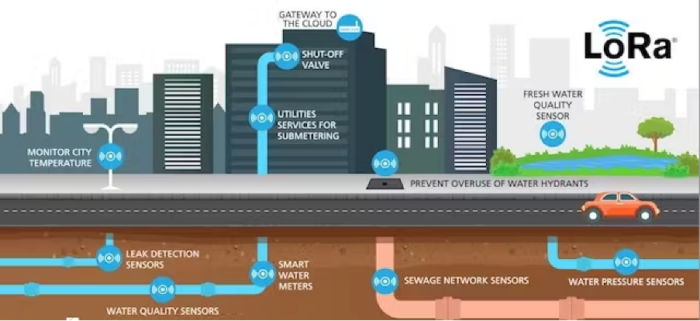A Drop Saved is a Drop Earned
India faces a growing water crisis—not just due to scarcity, but due to massive water leakages that go undetected across urban and rural infrastructure. As per a report by the Ministry of Jal Shakti, India loses about 40-50% of its piped water due to leakages, theft, and poor infrastructure. In some cities, non-revenue water (NRW)—the water that is produced but not billed—exceeds 50%, which is significantly higher than the global benchmark of 15%.
India cannot afford to lose half its water before it reaches consumers. The good news is, we now have the tools to monitor, manage, and control water infrastructure in real time. IoT and LoRaWAN are not futuristic technologies—they are today’s solutions for a water-secure tomorrow.
If adopted at scale, they can revolutionize how Indian municipalities track consumption, plug leaks, reduce waste, and ensure every drop is counted—and valued.
Key Stats at a Glance
40-50% of piped water in India is lost before reaching consumers
Non-revenue water (NRW) in Indian cities can exceed 50%
Smart water solutions using private LoRaWAN network servers can reduce water losses by 20-40%
LoRaWAN sensors can run on battery for 5-10 years
IoT-enabled LoRaWAN smart meters improve billing accuracy by 90-95%The good news is, we now have IoT-based solutions like LoRaWAN water monitoring systems and smart water metering using secure LoRaWAN network servers to monitor, manage, and control water infrastructure in real time. IoT and LoRaWAN® are not futuristic technologies—they are today’s solutions for a water-secure tomorrow.
Why Leakages Remain Uncontrolled
Despite efforts to expand water access, real-time monitoring and control remain limited. Traditional water distribution systems in India often rely on manual valve operations, outdated meters, and infrequent monitoring. This results in:
- Undetected underground leaks that go unresolved for months
- Incorrect or delayed billing
- No accountability for water usage
- Wastage of treated water, which incurs high energy and operational costs
Moreover, most municipalities lack a scalable LoRaWAN network server and digital infrastructure to track water usage trends, identify anomalies, or engage in predictive maintenance.
The Promise of IoT and LoRaWAN in Water Management
Enter IoT (Internet of Things), and more specifically, LoRaWAN (Long Range Wide Area Network) private network servers—a low-power, cost-effective wireless communication technology tailored for remote monitoring applications like smart water management.
Key Benefits of LoRaWAN-Based Smart Water Solutions
Real-Time Leak Detection
Sensors placed at various nodes in the water supply system can immediately detect anomalies like pressure drops or abnormal flow rates, indicating leaks or unauthorized usage.Smart Metering & Automated Billing
IoT-enabled smart water meters can send usage data in real time, allowing municipal corporations to accurately bill customers. This eliminates billing delays, estimates, and manual errors.Data-Driven Maintenance
Predictive analytics using data from IoT devicesconnected to a scalable LoRaWAN network server can identify aging infrastructure and prevent major pipeline bursts before they happen.Remote Valve Control & Pressure Management
Water flow can be remotely controlled based on consumption trends or emergency requirements—helping in better resource allocation and drought management.
Why LoRaWAN is Ideal for India
India’s urban and semi-urban areas are densely populated and often lack continuous internet connectivity. Here’s where LoRaWAN private network servers outshines other wireless technologies:
Long-range coverage (up to 10-15 km in rural areas)
Low power consumption—ideal for battery-operated devices
Cost-effective deployment
Scalable—can cover entire cities with minimal infrastructure
Operates in unlicensed frequency bands, reducing cost barriers

Global Case Studies Using LoRaWAN
In France, LoRaWAN-enabled smart meters helped cut water losses by over 30%.
In Australia, leak detection sensors using LoRaWAN prevented 10 million liters of water loss annually in a single city.
The Indian Opportunity: Digitizing Municipal Water Infrastructure
Municipal corporations across India are under pressure to meet growing water demands while improving efficiency. IoT and LoRaWAN offer a practical and scalable solution to:
Reduce NRW by up to 40%
Enable 100% accurate billing
Improve customer satisfaction and trust
Lower operational costs by reducing manual interventions
Meet national goals under the Jal Jeevan Mission and Smart Cities Mission